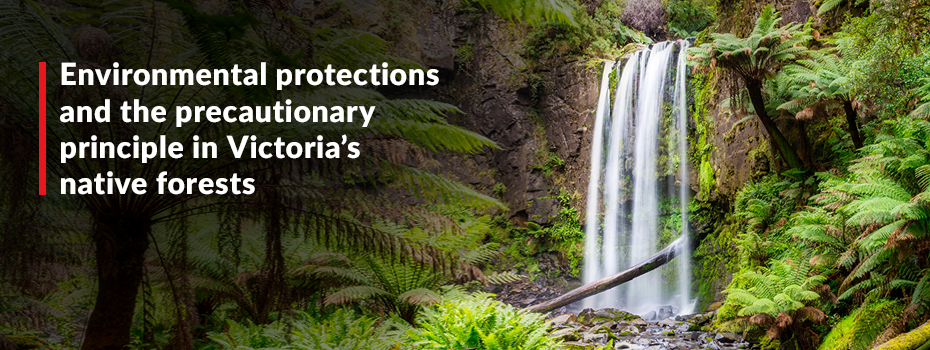
Environmental protections and the precautionary principle in Victoria’s native forests 2 Landmark Cases
15 June 2023 00:00
Nicola Silbert and Natalie Hogan ENVIRONMENTAL JUSTICE AUSTRALIA
These decisions contribute to the growing body of case law on the much-debated precautionary principle and form part of the environmental movement’s challenging of the State’s native timber industry, raising key questions in relation to its viability and legitimacy.
Both cases were brought by environment groups that undertake surveys for native species in Victorian forests. At trial, the plaintiffs produced and called evidence of the presence of threatened species and VicForests’ conduct, including evidence from witnesses who conducted species surveys and ecology experts. In both proceedings, the plaintiffs were successful in seeking injunctions against VicForests to prevent future damage to endangered species and environmental degradation.
What is the Warburton Environment v VicForests (No 5) case, and what does it mean for the future of VicForest’s operations? What has the ruling from the Environment East Gippsland Inc v VicForests (No 4) done to protect General and Yellow-Bellied Greater Gliders and their habitat? And what are the future implications of both of these cases?
This article comes from the experts behind the Australian Environment Review, the bulletin that provides updates and analysis on developments in environmental law throughout Australia and internationally. It includes in-depth commentary on government policy and legislation, as well as significant court cases. This is an ideal resource for legislators, policymakers, government officials, environment managers and engineers, water and power authorities, mining and oil companies, waste management companies and authorities, manufacturers and lawyers.
Subscribers to the Environment Law Bulletin can access the full article HERE.
At the end of 2022, two landmark cases were decided in relation to the application of environmental protections to logging practices in Victorian state forests:
- Warburton Environment v VicForests (No 5) [2022] VSC 633 (the “Warburton case”).
- Environment East Gippsland Inc v VicForests (No 4) [2022] VSC 668 (the “EEG case”).
VicForests is a state-owned enterprise established under the State Owned Enterprises Act 1992 (Vic) that conducts timber harvesting operations in Victorian State forests on a commercial basis. In doing so, it must comply with the provisions of the Sustainable Forests (Timber) Act 2004 (Vic) and any relevant Code of Practice made under Pt 5 of the Conservation, Forests and Lands Act 1987 (Vic). Currently, VicForests’ timber harvesting operations are governed by the Code of Practice for Timber Production 2014 (as amended 2022) (the “Code”), which incorporates the Management Standards and Procedures for timber harvesting operations in Victoria’s State forests (the “Standards”).
The two cases build on findings in earlier proceedings brought by community groups against VicForests, including Environment East Gippsland Inc v VicForests (the “Brown Mountain case”) and Friends of Leadbeater's Possum Inc v VicForests (No 4) (the “Possums case”). The plaintiffs in those cases successfully argued that VicForests’ past and planned timber harvesting activities were unlawful and breached the precautionary principle.
In the EEG case, the Court referred to the “damning” precautionary principle findings against VicForests in the Possums case, which were upheld on appeal. The Court observed that VicForests’ approach to its legal obligations some two years later was “strikingly similar”.
What is the precautionary principle and how was it applied in these two cases?
The precautionary principle stands for the proposition that where there are threats of serious or irreversible environmental damage, lack of full scientific certainty should not be used as a reason for postponing measures to prevent environmental degradation.
Clause 2.2.2.2 of the Code provides:
“The precautionary principle must be applied to the conservation of biodiversity values. The application of the precautionary principle will be consistent with relevant monitoring and research that has improved the understanding of the effects of forest management on forest ecology and conservation values.”
The Code refers directly to the Brown Mountain case as the guiding authority for the interpretation of that principle.
The Brown Mountain and Possums cases incorporate the oft-cited test of Preston CJ in Telstra Corp Ltd v Hornsby Shire Council, which sets out two preconditions to invoking the precautionary principle, namely:
- there is a real threat of serious or irreversible damage to the environment; and
- there is scientific uncertainty as to that environmental damage.
The interpretation and application of the precautionary principle were argued at length by the parties in the Warburton and EEG cases.
What is the Warburton Environment v VicForests (No 5) case, and what does it mean for the future of VicForest’s operations?
Warburton Environment Inc (“Warburton”) commenced proceedings against VicForests in the Supreme Court of Victoria in 2020. It sought injunctions and declarations to enforce environmental protections in the Code and the Standards relating to the endangered Tree Geebung (Persoonia arborea).
Tree Geebung is a shrub or small tree that is endemic to the Central Highlands of Victoria and is listed as endangered under the Flora and Fauna Guarantee Act 1988 (Vic). This slow-growing native species is threatened predominantly by fire and forestry operations.
The Court set out the four main provisions of the Code and Standards that affect Tree Geebung, namely:
- Section 2.2.2.10 of the Code, which requires VicForests to retain and protect long-lived understorey species within each coupe. It also provides that where chapter 4 of the Standards contains prescriptions for a particular type of long-lived understorey species that are applicable to the timber harvesting operations in a coupe and the requirements of all applicable prescriptions in that chapter have been complied with, compliance with the applicable prescriptions is taken to be compliance with s 2.2.2.10 in respect of that species;
- Clause 4.2.1.3 of the Standards, which provides that if the presence of a value listed in Table 14 (Rare or threatened flora prescriptions) is verified, VicForests is to apply and undertake any associated management action specified in the Table. The Management Action prescribed in Table 14 in respect of Tree Geebung is to “[p]rotect individual trees with a [diameter at breast height (1.3m) over bark] of at least 10cm from disturbance where reasonably practicable”;
- Section 2.2.2.4 of the Code, which requires VicForests to identify biodiversity values listed in the Standards prior to roading, harvesting, tending and regeneration, and to address risks to these values through management actions consistent with the Standards; and
- Section 2.2.2.2 of the Code relating to the application of the precautionary principle.
The arguments in the Warburton case
VicForests approved an amended Special Management Plan for Tree Geebung in November 2021, and a further version in July 2022 (“SMP”). The principal issues in the case were whether VicForests’ compliance with the SMP was sufficient to meet the requirements of the Code and Standards and, if not, what relief, if any, should be granted.
VicForests relied on the SMP as preventing further environmental degradation of the Tree Geebung population while Warburton argued that the SMP was inadequate and would not prevent ongoing degradation of the Tree Geebung population. Warburton argued that VicForests had failed to comply with the Code and Standards in the past when harvesting timber in the Central Highlands of Victoria and that non-compliance with environmental protections for Tree Geebung specimens would continue into the future without injunctions or declarations.
Warburton further argued, and called evidence to establish, that the precautionary principle was engaged in relation to Tree Geebung. VicForests argued “that there was no relevant threat of serious or irreversible damage to the environment as Tree Geebungs responded well to disturbance and those seedlings were regularly observed in coupes following timber harvesting”. Further, VicForests submitted that the threat was less “as timber harvesting will conclude in 2030 and that 40% of Tree Geebung were in areas protected from timber harvesting, including national parks.”
The proceeding was “heavily contested” coupe by coupe and, prior to the commencement of the trial, the Court had made approximately 40 interlocutory orders and given 18 interlocutory judgments, including a judgment from the Victorian Court of Appeal.
The Court’s findings in the Warburton case
In its ruling, the Court held that there was “compelling and uncontested” evidence that the past practices of VicForests and its contractors led to the loss of many Tree Geebungs in the harvestable areas of coupes. It found that:
The deficiencies in past practices identified in the evidence include:
- (a)the failure to conduct targeted surveys to detect and locate mature Tree Geebungs in coupes prior to harvesting;
- (b)the failure to provide sufficient, or any, buffers to protect mature Tree Geebungs during harvesting or from the later effects of windthrow; and
- (c)the failure to protect mature Tree Geebungs from the impacts of regeneration burning in coupes following harvesting.
As to VicForests’ past harvesting and burning practices, the Court determined on the evidence that:
… it is highly likely that significant numbers of mature Tree Geebungs have been lost in the Central Highlands in the past through harvesting and regeneration burning. The precise extent of the loss will never be known, but on the basis of recent records it is likely to amount to many hundreds or even thousands of mature trees.
The Court found that VicForests had logged in breach of the Code, including the precautionary principle and requirements to identify and protect Tree Geebung specimens in logging coupes. Further, the SMP was insufficient to meet VicForests’ legislative requirements, and that:
… compliance with the Code and Standards requires targeted pre-harvest surveys of coupes to identify and locate mature Tree Geebungs, the provision of proper buffers during timber harvesting, and wider firebreaks to protect mature Tree Geebungs within buffers from the destructive effects of regeneration burning.
The Court found that whether or not the precautionary principle was engaged in the proceeding made no difference to the ultimate outcome which was reached through the application of the Code, Standards and, in particular, the Management Action. However, it concluded that Warburton had established that:
… there is a threat of serious or irreversible damage to the Tree Geebungs as a species and to the environment by reason of the proposed timber operations and regeneration burning over the next eight years.
His Honour Justice Garde noted that “[d]estruction of mature Tree Geebungs cannot be rectified for a very long time and may not ever be rectified due to the age of mature trees required to produce substantial quantities of seed.”
His Honour further observed that, in the context of the precautionary principle, “the evidentiary burden of showing that the threat does not exist or is negligible reverts to VicForests.”
Final orders in the Warburton case
His Honour found that injunctive relief was necessary to ensure future compliance with the Code and Standards. Relief was granted in the form of final injunctions and orders which, in effect, prevent VicForests from carrying out timber harvesting operations in any Wet Forest coupe in the Central Highlands unless, prior to commencing, it carries out proper surveys for Tree Geebung specimens and imposes 50-metre buffers around “specified Tree Geebungs”. In the course of carrying out timber harvesting operations, including regeneration burning, VicForests is required to impose specified buffers and firebreaks. VicForests is required to comply with these measures “where practicable”, in accordance with Code prescription.
What has the ruling from the Environment East Gippsland Inc v VicForests (No 4) done to protect General and Yellow-Bellied Gliders and their habit?
Environment East Gippsland Inc (“EEG”) and Kinglake Friends of the Forest Inc (“KFF”) commenced a joint proceeding against VicForests in 2021. Like other environmental groups including Warburton, EEG and KFF sought to enforce VicForests’ obligations under the Code and in relation to the precautionary principle. EEG and KFF sought similar relief to Warburton, this time in respect of VicForests’ obligations to identify and conserve Greater Gliders (“GG”) and Yellow-bellied Gliders (“YBG”) in the East Gippsland and Central Highlands forestry management areas respectively.
The GG and the YBG are gliding marsupials native to eastern Australia. Both species are threatened by timber harvesting and fire and are facing a high risk of extinction in the wild. Both species are listed under the Environment Protection and Biodiversity Conservation Act 1999 (Cth). In July 2022, GGs were uplisted from vulnerable to endangered.
The arguments in the Environment East Gippsland Inc v VicForests case
The plaintiffs argued that ss 2.2.2.2 and 2.2.2.4 of the Code required comprehensive pre-harvest surveys of a coupe scheduled for harvesting to determine whether GGs and YBGs were present within the coupe and, if they were present, identification of the location of the gliders’ home ranges. The plaintiffs also argued that those provisions required VicForests to exclude an area of forest from harvesting around the location of each sighting of a GG or YBG. In addition, EEG argued that VicForests was not meeting its obligations under cl 4.2.1.3 of the Standards to apply a protection area of approximately 100 hectares of suitable habitat around certain populations of GGs and YBGs.
VicForests rejected the plaintiffs’ interpretation of the prescriptions in the Code as to survey requirements and argued that the measures taken to detect and protect GGs and YBGs were adequate. Specifically, VicForests said that it correctly applied s 2.2.2.4 when planning timber harvesting operations in East Gippsland, and that s 2.2.2.4 had no application in the Central Highlands in relation to GG and YBG. In the East Gippsland proceeding, VicForests maintained that it met its obligations under cl 4.2.1.3 of the Standards.
VicForests further argued that the precautionary principle was not engaged in relation to those species. VicForests submitted that s 2.2.2.2 should be construed narrowly, and that the precautionary principle is only engaged in circumstances where specific timber harvesting operations present a threat of serious or irreversible environmental damage.
The Court’s findings in the Environment East Gippsland Inc v VicForests case
The Court held that VicForests breached its obligations under the Code and granted relief, including injunctions that prevent VicForests from logging in East Gippsland or the Central Highlands unless it has completed surveys for GGs and YBGs, excluded logging from the home range of GGs, and retained a higher proportion of trees in coupes where GGs or YBGs are detected.
The Court rejected VicForests’ argument about the test for the precautionary principle. VicForests argued that the Brown Mountain case changed the principle so that a lack of scientific certainty was no longer a precondition to its application and the only precondition was the threat of serious or irreversible environmental damage. The Court clarified the precautionary principle test and confirmed that VicForests must always apply the precautionary principle to conservation and biodiversity values, including when planning and conducting timber harvesting operations, consistent with Telstra Corporation Ltd v Hornsby Shire Council.
The precautionary principle was engaged in relation to GGs and YBGs on the basis that VicForests’ timber harvesting operations posed a threat of serious and irreversible damage to both GGs and YBGs, which are at risk of extinction. In determining whether there is an objective threat of serious or irreversible damage to the species, the Court considered all threats, including “direct and indirect threats, secondary and long-term threats and the incremental or cumulative impacts of multiple or repeated actions or decisions”. There was a lack of scientific certainty about the nature and extent of the threats, including the effect of timber harvesting operations on the species.
The Court found that VicForests’ approach to timber harvesting fell “well short” of what the precautionary principle requires. The evidence was that GGs and YBGs that “live in coupes that are harvested in accordance with VicForests’ current practices will probably die as a result of the harvesting operations.”
Final orders in the Environment East Gippsland Inc v VicForests case
Expert ecologists called by the plaintiffs and VicForests gave evidence as to measures which would protect GGs and YBGs from the effects of timber harvesting operations in their habitat and recommended two alternative suites of measures. The Court selected those measures which it considered more proportionate and made orders to that effect.
For GGs, this involves retaining a home range area for individuals within the coupe, at least 60% of the basal area should be retained, protecting suitable habitat features such as hollow-bearing trees and feed trees in the remainder of the coupe.
For YBGs, the orders involve identifying and retaining feed trees, recruitment trees, and hollow-bearing trees in addition to at least 60% of the basal area across the coupe. VicForests must also use a survey method that is likely to detect gliders that may be present and locate their home ranges.
What are the future implications of these two landmark environmental law cases?
The landmark Warburton and EEG cases put species in the spotlight and are the first Supreme Court judgments to protect Victoria’s unique threatened plants and animals from logging in native forests. The resulting injunctions have caused VicForests’ logging industry to pause in the Central Highlands and East Gippsland Regional Forest Agreement regions. Meanwhile, VicForests continues to defend several other similar cases brought by community groups. The Warburton and EEG cases are not isolated cases; they are crucial pieces in a swell of litigation aimed at protecting native forests in Victoria by enforcing environmental laws and bolstering calls for an immediate transition away from native timber harvesting.
At the time this bulletin article was released, both cases were before the Victorian Court of Appeal.
Would like to subscribe to our Australian Environment Review Bulletin?
Latest Articles
-
 Gayann Walkers is a well-respected Victorian Barrister. Tis interview focuses on what it takes to be a Barrister in sports law, and what the future of the field looks like.
Gayann Walkers is a well-respected Victorian Barrister. Tis interview focuses on what it takes to be a Barrister in sports law, and what the future of the field looks like. -
 The growth of artificial intelligence technologies in Australia has recently come under the spotlight, as the Albanese Government looks to review existing regulatory and governance mechanisms and establish applicable safeguards that are fit for purpose in the current day and age.
The growth of artificial intelligence technologies in Australia has recently come under the spotlight, as the Albanese Government looks to review existing regulatory and governance mechanisms and establish applicable safeguards that are fit for purpose in the current day and age. -
 Artificial Intelligence (AI) is developing fast – but how should it be used? Over the past month, the ethical use and development of AI have been heavily scrutinised as policymakers, intellectuals, and industry leaders debate whether a moratorium should be imposed on AI’s development, or whether AI should be embraced in the name of economic growth.
Artificial Intelligence (AI) is developing fast – but how should it be used? Over the past month, the ethical use and development of AI have been heavily scrutinised as policymakers, intellectuals, and industry leaders debate whether a moratorium should be imposed on AI’s development, or whether AI should be embraced in the name of economic growth.
Practical Guidance
Your one-stop solution for accurate legal answers from Australian legal experts. Tools, practically focused guidance notes, checklists, precedents, and training materials support and streamline your legal workflow.
LEARN MORE LexisNexis
LexisNexis